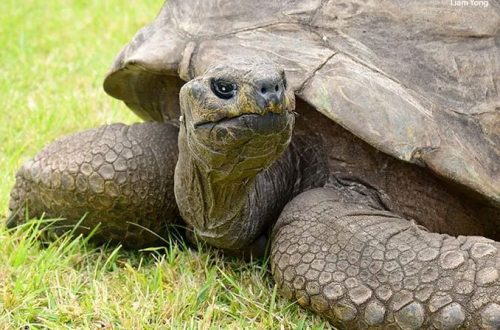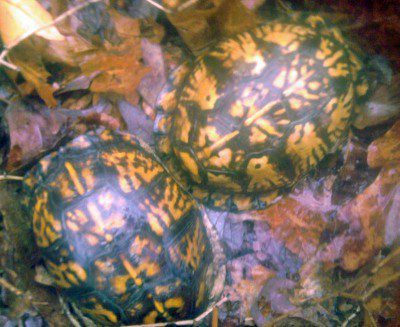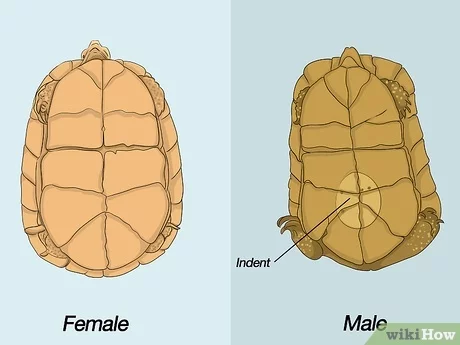
How turtles breed in nature and at home

Everyone’s favorite turtles are one of the most ancient animals on Earth; in nature, the turtle reproduces naturally, laying several hundred eggs per season. Reptiles have been kept at home as pets for a long time, but not every owner manages to breed turtles at home. The reason for this phenomenon is the lack of knowledge of the physiology of unusual animals, an unbalanced diet and violation of the conditions of feeding and keeping. But with a competent approach to the process of breeding turtles in captivity, even beginners manage to get tiny cute reptiles.
Contents
How sea, freshwater and land turtles breed in nature
All species of turtles, regardless of habitat conditions, have a common development cycle, which in the form of a diagram looks like this: an adult – an egg – a calf – a young – an adult.
Almost all turtles, with rare exceptions, do not care about their offspring, the female forever forgets about the cubs after laying eggs.
Reproduction of turtles in nature
Reptiles reproduce when they reach sexual development, freshwater turtles mature at 6-8 years old, and land turtles at 10-15 years old. Sea turtles begin to breed only at 10-24 years. The period of puberty in each species depends on the individual characteristics and living conditions.
When puberty is reached, males and females begin to acquire external differences. Females grow much larger than males of their species, this feature is associated with future reproduction, up to 200 eggs can be in the body of a female during pregnancy !!! Males most often have a concave part of the abdomen, which helps them to stay on the female’s shell at the time of mating.
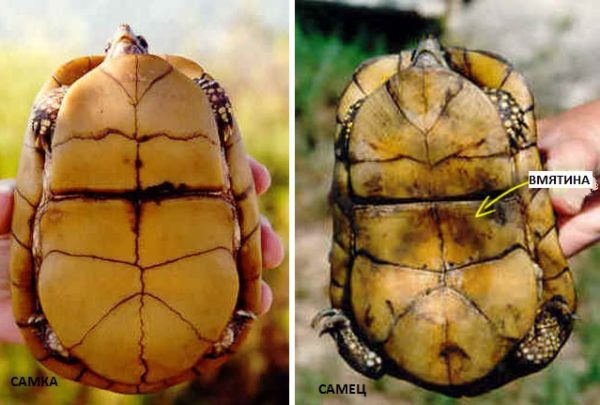
Male sea and freshwater turtles have long claws on their limbs, also used to fix animals when copulating in the water. The mating process of land turtle species occurs only on land. Before sexual intercourse, all types of reptiles have a mating season, which is necessary for creating pairs and successfully fertilizing the female turtle.
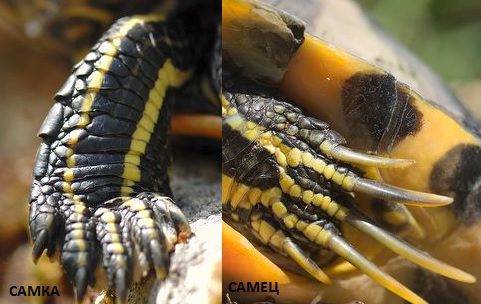
Mating games and mating turtles in nature
The mating season for different types of turtles is interesting and beautiful in its own way. Hormonal restructuring forces males to fight with competitors for the right to mate with females and show the skill of courting their chosen ones.
In red-eared turtles, males very delicately lure the “lady”, the male swims with his tail forward nose to nose to the female, stretching his forelimbs. At the time of love games, the boy’s long claws vibrate from touching the cheeks of the girl he likes. Male freshwater turtles do not show aggression towards the opposite sex, but females can bite an annoying suitor quite strongly. Between themselves, males arrange bloody battles, but the second male retreats if the female has chosen his competitor.

The breeding environment of the sea turtle is the birthplace of the female, for this reptiles swim hundreds of thousands of kilometers before the onset of the mating season. Female sea turtles lay fertilized eggs only in those places where they hatched themselves. During the mating season, male marine reptiles sing loud songs and compete for the right to own a female. Unlike their freshwater relatives, an offended competitor can attack the offender and bite him even at the time of copulation.
Video: mating games of red-eared turtles
Boys of Central Asian tortoises, in the presence of a female they like, also arrange fights with serious injuries. Males jump on each other and try to turn the competitor onto their back with the help of spurs located on the abdominal scutes. Suitors walk in a circle, make warlike sounds, until one of the males retreats.
After the emergence of mutual interest, mating occurs. Freshwater reptiles mate directly in the water, the gentleman hugs his chosen one from behind with his forelimbs and releases sperm into the female’s genital tract within 5-15 minutes. Sexual intercourse in aquatic species of turtles can take place only with a favorable attitude of the female to the courtship of the male.
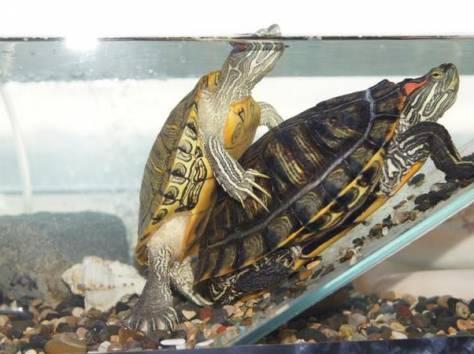
Sea turtles copulate in their native element at the bottom or near the surface of the water; for breeding, reptiles swim to the shore at a distance of no more than a kilometer. During sexual intercourse, the gentleman saddles the female, pressing her to the bottom with his abdomen, or copulates, fixing the female from behind with his front paws.

Land tortoises do not always breed with the consent of the female. With mutual interest, the female freezes for sexual intercourse, the male long and thoughtfully sniffs out her tail. Then, very slowly, the gentleman climbs onto the shell of the chosen one, digs into her neck with his beak and makes forward movements.  If the female is afraid of courtship and runs away from the male, then the boy becomes very aggressive and nimble. He intimidates the girl with blows on her shell, the groom can even bite the rebellious bride. A frightened female stops running away, hides her front paws and head in her shell, at this moment her tail part comes out, which is used by an aggressive male. He climbs on the girl and with loud warlike cries performs sexual intercourse.
If the female is afraid of courtship and runs away from the male, then the boy becomes very aggressive and nimble. He intimidates the girl with blows on her shell, the groom can even bite the rebellious bride. A frightened female stops running away, hides her front paws and head in her shell, at this moment her tail part comes out, which is used by an aggressive male. He climbs on the girl and with loud warlike cries performs sexual intercourse.
Video: mating games and mating of Central Asian tortoises
Egg laying and hatching of baby turtles
Pregnancy of different species of turtles lasts from one to three months, after which the pregnant female looks for a convenient place to lay eggs. Both aquatic and land reptiles lay up to 100-200 eggs at a time, one female can make 3-4 clutches per season. Under natural conditions, turtles breed in huge numbers, but only a few out of hundreds of laid eggs survive and become adults. It is at the stage of egg, baby and young turtles that become food for foxes, jackals, birds of prey, fish and even people.
In nature, mating occurs in the spring, and in the summer the females lay eggs. Warm sand close to water bodies is considered an ideal place to build a nest. Sea turtles dig holes so far from the sea that newborn turtles can quickly get to the water, but the surf cannot wash away the masonry.
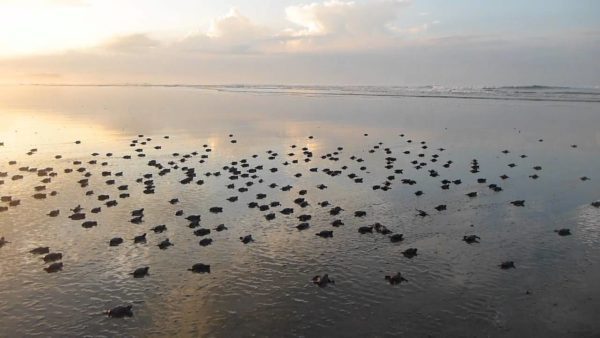
Having chosen a place, the female digs a deep pitcher-shaped hole with powerful hind legs, moving in a circle and wetting the sand with cloacal fluid. After the construction is completed, the female hangs her hind limbs into the nest and lays one egg at a time. Sea turtles lay eggs only at night, other species are not tied to the time of day. In the interval between the release of each egg, the female gently corrects the previous one with her hind paw. After laying all the eggs, the animal carefully compares its masonry with sand, slams it with its belly, moistens it with urine and leaves, forever forgetting about its babies.
After 1-3 months, depending on the species, small turtles cut the shell from the inside with an egg tooth. Babies are born with a yolk sac, which is a source of nutrients. Having strengthened, newborn reptiles begin to quickly work with their limbs, shaking off the sand and getting out of the nest. Aquatic species of turtles immediately run to the water. Part of the freshwater, sea and land turtles will become food for fish and predatory animals, only a few will grow into mature individuals, which will begin further reproduction.
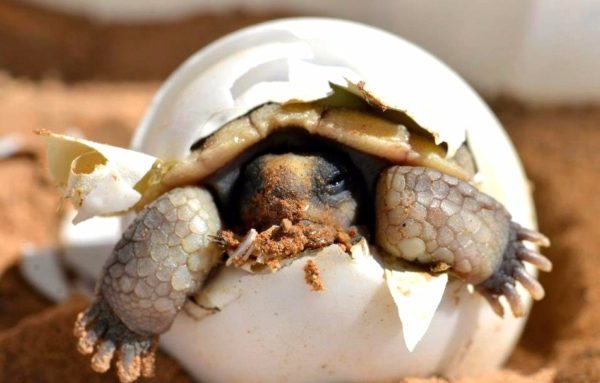
Breeding turtles at home
At home, turtles breed quite hard, animals of different sexes can be kept in the same territory all their lives and not start the process of procreation. For the successful breeding of reptiles, several conditions must be met:
- it is recommended to select for mating only sexually mature healthy individuals of the same species, young and elderly turtles are not used to create a pair;
- stimulate the hormonal background of aquatic species by prolonged wintering, the reproduction of land turtles at home occurs without additional stimulation;
- before meeting, keep separate individuals of different sexes, which will arouse the interest of males;
- two weeks before the expected date of mating, transfer animals to enhanced nutrition with the addition of vitamins and trace elements;
- before introducing, increase the water temperature in the aquarium for aquatic species and the length of daylight hours for all reptiles;
- create groups of several females and one male for freshwater and sea turtles. It is better to breed land turtles at home when creating a group of 2-3 males and one female;
- a love couple is planted in a separate terrarium or aquarium, preferably on the territory of the male, placing a container with sand in them;
- after mating, the pregnant female is kept separately from the male;
- after 60 days, the female will lay eggs, the eggs of domestic turtles resemble white balls 3-4 cm in diameter;
- eggs are carefully placed in an incubator or glass jar for incubation;
- maturation of turtle eggs takes 2-5 months at a temperature of 28-30C;
- babies break through the shell on their own and hatch from eggs in 1-3 days;
- on the 5th day, cubs of land species are bathed in warm boiled water, and babies of sea and freshwater turtles are allowed to be taught to swim in a separate pool from the 3rd-5th day;
- from the end of the first week, new family members are treated to adult food according to the type of reptile.
Any owner can breed turtles at home when creating ideal breeding conditions for small pets and carefully studying their physiology.
Reproduction of sea and land turtles at home and in the wild
3 (60%) 38 votes



